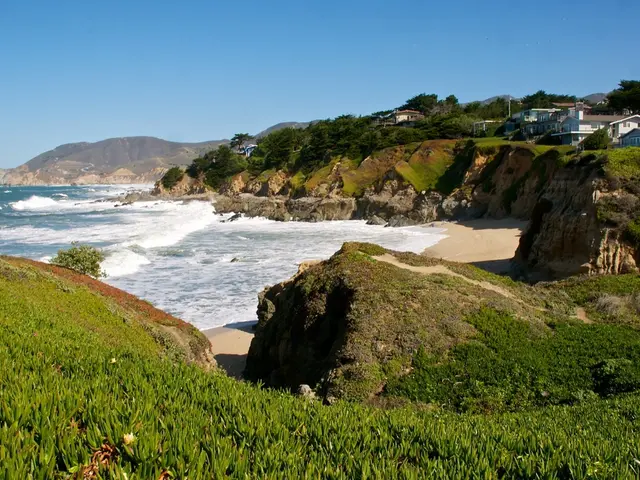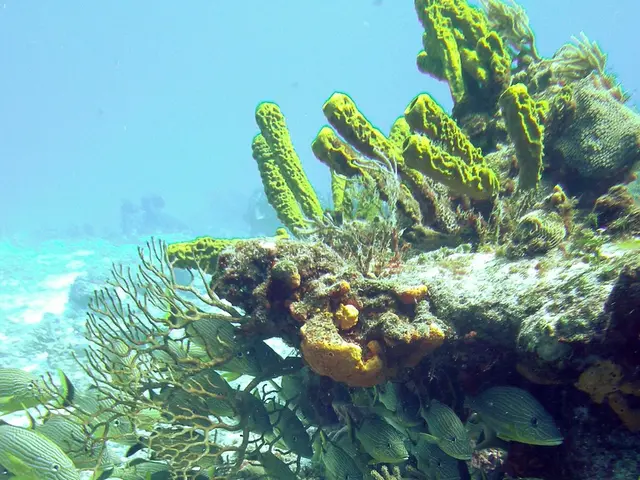The Changing Beautiful Landscapes of Our Planet: A Traveler's Guide
Vulnerable Travel Spots Threatened by Climate Change: Reasons and Best Timing for Visits
In today's world, the planet's most stunning landscapes are facing rapid change due to rising temperatures, melting ice, and shifting ecosystems. For those dreaming of witnessing these marvels, the time is now. This guide will take you on a journey to some of the most breathtaking yet imperiled sites, providing tips on when to visit, why it matters, and what you'll experience.
1. The Great Barrier Reef, Australia
The world's largest coral reef is persevering in a battle for survival against climate change and water pollution. Tragically, mass bleaching events have robbed the reef of some of its iconic color and vibrancy. The fight isn't over, with conservation programs striving to turn the tide while you can still experience the awe-inspiring coral and marine life.
Visiting Time: June to October [dry season]
Why Go: Clearer water and improved visibility make these months the best time for underwater exploration.
What You'll See: A kaleidoscope of vibrant corals, schools of tropical fish, and other fascinating marine creatures up close. Opt for eco-friendly tour operators to support conservation efforts.
2. Venice, Italy
This iconic "Floating City" is quite literally at risk of sinking. Increasing flooding caused by sea-level rise and higher tides, known locally as "acqua alta," is gradually threatening historic infrastructure. Visiting Venice now provides a chance to support sustainable tourism initiatives and witness pioneering flood barrier projects.
Visiting Time: Spring or fall [thinner crowds, reduced flooding]
What You'll Experience: Beyond the gondolas and canals, explore Venice's brave efforts to combat the tides and preserve its unique character.
3. Antarctica
The icy landscapes of Antarctica are disappearing faster than ever due to melting ice and its contributions to global sea-level rise. As temperatures rise, so do concerns for the species call Antarctica home, such as penguins and seals. Setting foot on this pristine continent will grant you an unforgettable experience and open your eyes to the realities of climate change.
Visiting Time: November to March [southern hemisphere's summer, active wildlife]
What You'll Experience: Glaciers, icebergs, penguin colonies, and more await you on eco-conscious expeditions that support scientific research.
4. The Maldives
Known for its turquoise waters and idyllic beaches, the Maldives is one of the most vulnerable places to sea-level rise. Entire communities may be displaced if rising tides persist. The beauty of this low-lying island nation can still be savored, but choose eco-conscious resorts for responsible tourism and support resilience initiatives.
Visiting Time: December to April [clear skies, calm seas]
What You'll Experience: Stunning coral reefs, white sandy beaches, and diverse marine life await on a paradisal getaway.
5. Alaska, USA
Alaska's glaciers are melting rapidly, altering landscapes and affecting wildlife. From polar bears to salmon, various species are feeling the impact. Exploring Alaska provides a rare opportunity to witness these changes first-hand and learn from knowledgeable guides about the realities of climate change on local ecosystems.
Visiting Time: June to August [warmer days, endless daylight]
What You'll Experience: Towering glaciers, fjords, and diverse wildlife await you on an adventure-filled trip.
6. The Amazon Rainforest, Brazil
Dubbed the "lungs of the planet," the Amazon faces severe deforestation and climate-driven changes that threaten its incredible biodiversity. Venturing into this critical ecosystem offers a one-of-a-kind experience while supporting sustainable tourism and conservation efforts.
Visiting Time: June to November [drier weather, easier river access]
What You'll Experience: Dense forests, unique wildlife, and indigenous cultures await in this unparalleled natural wonder.
7. Glacier National Park, USA
Over 120 glaciers have vanished from Glacier National Park due to climate change, prompting concerns that the remaining glaciers may disappear within a few decades. This park offers opportunities to learn about the realities of climate change and witness its tangible effects on the environment.
Visiting Time: June to September [accessible hiking trails, mild weather]
What You'll Experience: Alpine meadows, rugged mountain landscapes, and crystal-clear lakes await you in this frozen realm.
8. The Dead Sea, Jordan/Israel
Rising sea levels threaten the Dead Sea, causing it to shrink at a rapid pace. This unique ecosystem is at risk of disappearing entirely. Amid the stunning scenery, you can support local efforts to preserve this one-of-a-kind destination.
Visiting Time: Late fall to early spring [mild temperatures, perfect for floating]
What You'll Experience: Relax on the therapeutic, dense waters, explore nearby historical sites, and aid conservation efforts.
9. The Seychelles
The Seychelles' islands are threatened by rising sea levels that put entire communities at risk. Witnessing the beauty of these tropical paradises promotes awareness for the urgent need for climate change action and supports sustainable tourism initiatives.
Visiting Time: April, May, October, and November [calm seas, mild weather]
What You'll Experience: White sandy beaches, colorful coral reefs, and diverse marine life await you on a eco-friendly vacation.
10. The Alps, Europe
Europe's Alps are enduring shorter, warmer winters and rapid glacier melting, impacting local communities and traditional winter tourism. Visiting the Alps in summer or winter offers breathtaking landscapes and insight into the effects of climate change on mountain ecosystems.
Visiting Time: December to March [winter sports] or late summer [hiking and mountain views]
What You'll Experience: Stunning snowy peaks, charming alpine villages, and untouched trails await you in this changing landscape.
Ready for an adventure? Pack your bags and explore these incredible destinations before they change forever. Choose eco-conscious travel options, respect local guidelines, and embrace each extraordinary experience.
- When considering a trip to witness the beautiful but imperiled landscapes of our planet, consider integrating environmental science and lifestyle choices to minimize your impact. For instance, prioritize eco-friendly travel options, such as carbon-neutral flights and public transportation, to reduce your carbon footprint.
- Science plays a crucial role in understanding and addressing pressing issues related to climate change in travel destinations. In venues like the Great Barrier Reef in Australia, take the opportunity to learn about conservation programs and initiatives aimed at preserving the reef and its marine life.
- As a responsible traveler, it's essential to support local communities and their efforts to combat climate change. In Venice, Italy, encourage sustainable tourism by choosing eco-conscious accommodations and dining options that support the local economy and conservation efforts.
- Adventure-travelers can incorporate cultural-travel elements into their itineraries to gain a deeper understanding of the challenges faced by destinations impacted by climate change. In the Seychelles, for example, participate in local workshops or lectures focused on the effects of sea-level rise and the importance of sustainable tourism.
- Budget-travelers should keep in mind that eco-friendly decisions don't have to break the bank. By selecting accommodation options with sustainable practices or exploring local activities, you can travel responsibly while keeping costs low. In Glacier National Park, opt for budget-friendly camping sites and hiking trails, and learn about climate change from park rangers during guided tours.
- Support scientific research in your travel choices by choosing tour operators that contribute to ongoing studies or programs focused on climate change and its impact on various ecosystems. In both the Amazon Rainforest and Antarctica, select tour providers that invest in conservation efforts and support researchers working to understand the effects of climate change on these unique locations.
- Reflect on the landscape changes you experience and consider how they connect to the broader issue of climate change. Sharing your observations and experiences with others can help raise awareness and inspire action. Upon returning home from your travels, educate friends and family about the impact of climate change on these incredible destinations and encourage them to make sustainable lifestyle choices.
- Overall, approach travel as an opportunity not only for adventure and cultural exchange but also as a chance to engage with, learn from, and support the efforts of local communities battling the effects of climate change. By making eco-conscious decisions and embracing responsible tourism, you can play a role in preserving these marvelous sites for future generations.




